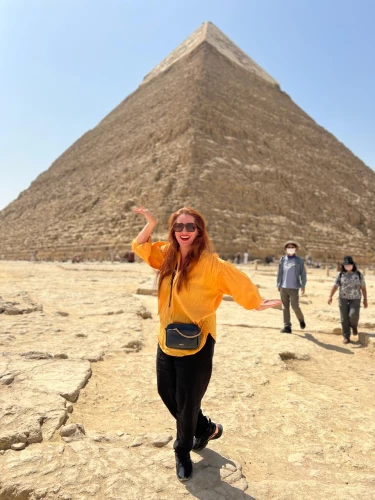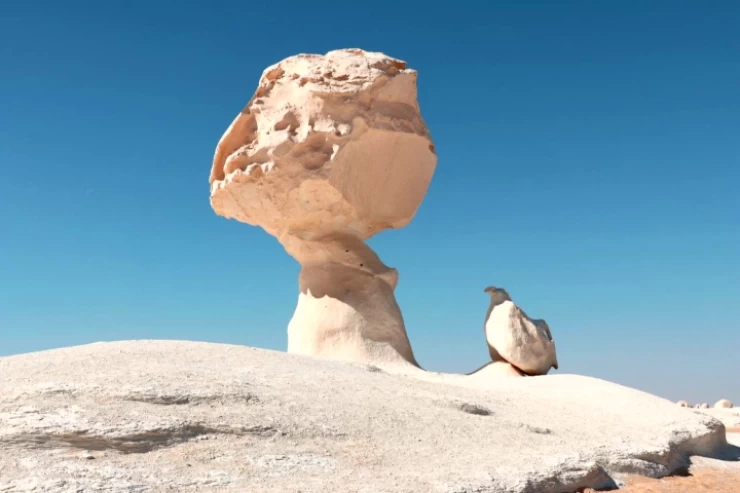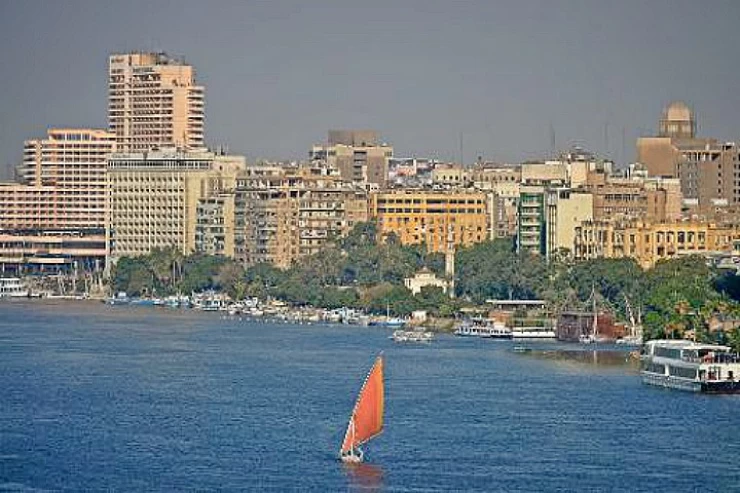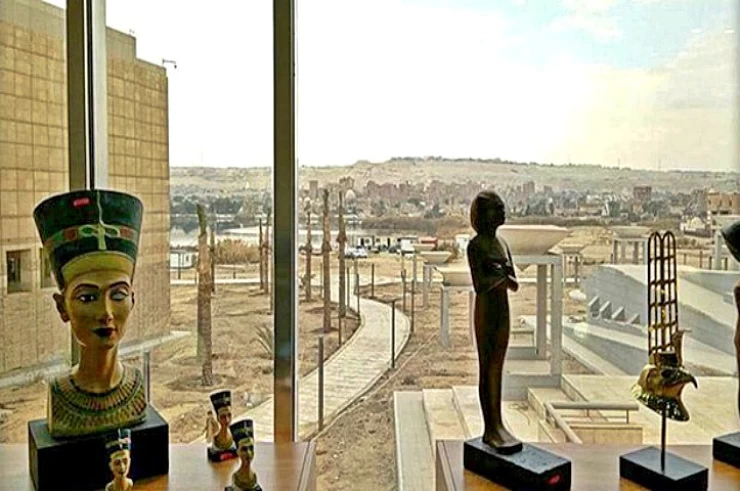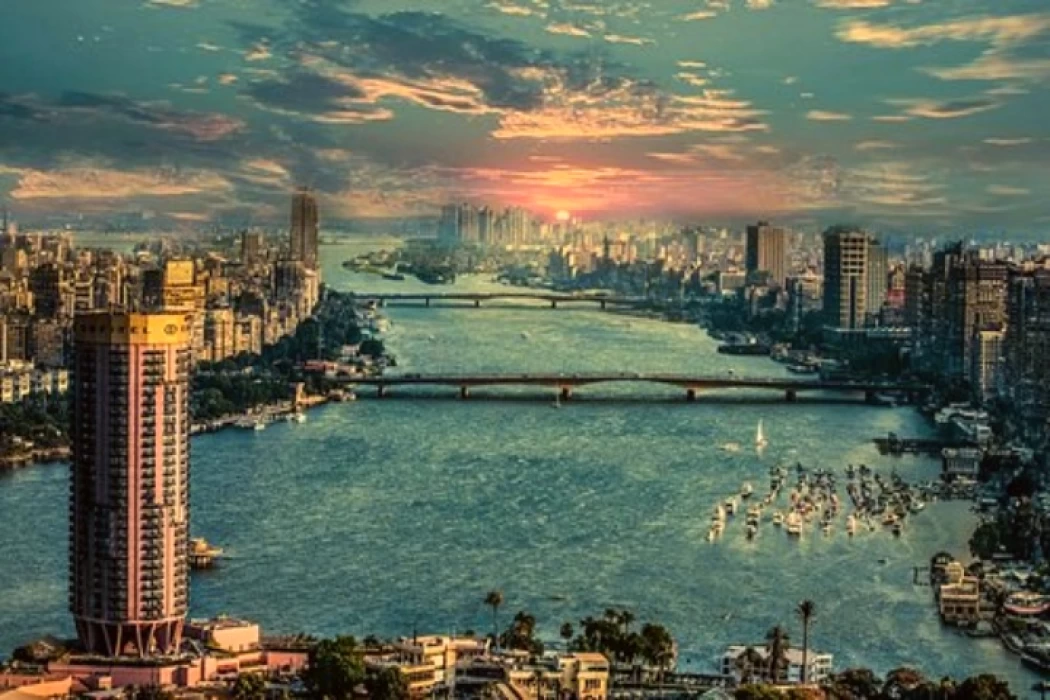
Gouvernement Kairo Ägypten | Kairo Geschichte | Kairo Attraktionen
Geschichte von Kairo
Die Stadt wurde während der Fatimiden-Dynastie von el Muez le din Allah el Fatemi oder el-hakim be Amr Allah gegründet und erhielt von ihm den Namen Kairo oder auf Arabisch el Kahera (die Siegreiche). Sie ist auch bekannt als die Stadt der tausend Minarette aufgrund der zahlreichen Moscheen, Schlösser und Kirchen, die sich in ihr befinden. Sie ist berühmt dafür, die Hauptstadt Ägyptens zu sein.
Die berühmtesten Attraktionen von Kairo:-
1-das Ägyptische Museum
Das Museum wurde 1857 von dem französischen Archäologen Auguste Mariette gegründet und zog 1897 in sein heutiges Domizil ein - in das markante puderrosa Herrenhaus in der Kairoer Innenstadt.
Die Sammlung ist schlecht beschriftet und aufgrund der begrenzten Fläche nicht gut erschlossen (und nur ein Bruchteil der gesamten Bestände ist buchstäblich zu sehen).
Es leidet unter einigen leeren Vitrinen, da die Artefakte bereits in das bisher versiegelte neue Grand Egyptian Museum (GEM) überführt wurden, aber Sie werden von der Schönheit der Exponate beeindruckt sein.
Die hier gezeigten Schätze wurden alle im Grab von Tutanchamun gefunden, dem Nachfolger von Amenophis IV (später Echnaton), der im Alter von achtzehn Jahren starb.
Das Grab, das 1922 von Ägyptologen im Tal der Könige entdeckt wurde, enthielt die größte Ansammlung von Grabbeigaben, die je in einem ägyptischen Grab gefunden wurde. Tutanchamun's Abgüsse und Sarkophage (Raum 3), der Löwenthron des Pharaos (Raum 35) und seine faszinierende Garderobe (Raum 9).
Die Tutanchamun-Galerien werden positiv beeinflusst und können die Highlight-Ausstellung im neuen GEM bilden. In der Zwischenzeit, im gregorianischen Kalendermonat 2020, wurde die Sammlung der königlichen Mumien aus dem ägyptischen Depot in das National Museum of Egyptian Civilizations (NMEC) überführt, um die große Menge an ägyptischen Grabbeigaben auf die Kairoer Museen aufzuteilen.
Dieses neu entdeckte Grabmal sowie viele andere schöne Felsen- Dieses neu entdeckte Grab sowie viele andere schöne Felsengräber der berühmten Pharaonen können in Kürze im Tal der Könige durch Luxor Tagesausflüge erkundet werden, auch wenn Sie den Zug für ein paar Stunden nach Norden besteigen können, können Sie es auch während Assuan Tagesausflüge oder sogar unsere 2-Tages-Tour nach Luxor von Assuan gibt es eine Menge von Ägypten Tagesausflüge, die nach Luxor aus den verschiedenen ägyptischen Städten wie Hurgada Tagesausflüge auf dem Landweg nach Luxor gehen oder wenn Sie für einen gemütlichen Urlaub in Sharm kommen, können Sie das Flugzeug für einen Tag während Sharm El Sheikh Ausflüge nehmen, um alle der historischen Stadt zu erkunden.
2- Al-Azhar-Gotteshaus
Das Al-Azhar-Gotteshaus ist das schönste Gebäude der fatimidischen Ära in Kairo und eine der ältesten lebenden Moscheen der Stadt, die 972 n. Chr. fertiggestellt wurde.
Sie ist auch eine der ältesten Universitäten der Welt - Khalifah El-Aziz verlieh ihr im Jahr 988 n. Chr. den Titel einer Universität (die anderen Universitäten, die um den Titel "älteste" Universität wetteifern, befinden sich in Fes), und auch heute noch ist die Al-Azhar-Universität das führende Zentrum der monotheistischen Welt.
Der Haupteingang ist das Tor der Barbiere im Nordwesten des Gebäudes, das sich an die von Abbas II. entworfene neoarabische Fassade anschließt.
Auf der anderen Seite des Hofes befindet sich die Hauptgebetshalle, die sich über eine Fläche von 3.000 Quadratmetern erstreckt.
3- Das koptische Kairo
Diese winzige, mit Kirchen gefüllte Ansammlung gewundener Gassen liegt innerhalb der Mauern eines jüngeren Stadtzentrums, wo der römische Kaiser Marcus Ulpius Traianus ursprünglich eine Verteidigungsanlage am Fluss entwarf.
Teile der römischen Türme beherrschen noch immer die meisten Straßen.
Diese winzige, mit Kirchen gefüllte Ansammlung gewundener Gassen liegt innerhalb der Mauern eines neueren Stadtzentrums, wo der römische Kaiser Marcus Ulpius Traianus ursprünglich eine Verteidigungsanlage am Fluss errichtete.
Nebenan befindet sich die Hängende Kirche aus dem 9. Jahrhundert mit einigen schönen Beispielen koptischer Baukunst. Die im vierten Jahrhundert errichtete Kirche wurde ursprünglich über den römischen Tortürmen errichtet (daher der Name) und im neunten Jahrhundert erheblich umgebaut.
Für viele christliche Reisende ist der wichtigste Höhepunkt eines Besuchs in diesem Viertel die Kirche des heiligen Sergius und der griechisch-römischen Gottheit, wo der einheimischen Legende nach die Jungfrau Maria, das Jesuskind und die Familie während des Massakers von König Herodes an männlichen Babys in Sicherheit gebracht wurden.
Weiter im Viertel kommt man zum Tabernakel auf dem Berg Esra, das angeblich in der Nähe der Stelle errichtet wurde, an der das Baby Moses im Schilf gefunden wurde. Gleich außerhalb des Viertels besichtigen Sie das Haus der Anbetung von Amr Ibn al-As, das erste in Ägypten errichtete Haus der Anbetung.
4- Khan el-Khalili
Dieser Souq (Basar) ist eine labyrinthische Ansammlung von schmalen Gassen, die im Jahr 1400 n. Chr. als Ausgehviertel gegründet wurde und noch immer vom Klirren der Metallstäbe und Silberschmieden erfüllt ist.
Die Hauptstraßen haben sich längst voll und ganz dem Handel mit Urlaubern verschrieben (mit jeder Menge preiswertem Papyrusmaterial und Plastikpyramiden), doch wenn man von der Hauptstraße in die umliegenden Gassen abbiegt, findet man in den kleinen Läden und verstreuten Werkstätten einige der besten Plätze, um antike Waren in Ägypten zu kaufen.
Besuchen Sie das berühmteste Kaffeehaus Kairos, Fishawis, wo sirupartige arabische Gelegenheitsgetränke und süße Tees in rasantem Tempo Touristen und einheimische Händler gleichermaßen in Schale geworfen werden.
Für Einkäufer ist die Al-Muski-Straße (die an ihrem japanischen Ende Gawhar al-Qaid-Straße heißt) die wichtigste Souk-Straße.
Die Gold- und Silberwerkstätten befinden sich hauptsächlich nördlich der Kreuzung dieser Straße mit der Al-Muizz Li-Din Supreme Being Street, während der Gewürzmarkt im Süden liegt.
Der Markt wird auf der japanischen Seite durch das Sayyidna el-Husein-Gotteshaus begrenzt, das 1792 zu Ehren des Enkels des Propheten Muhammad errichtet wurde.
5- Die Zitadelle
Die Festung von Kairo wurde von Salah-ad-Din Yusuf ibn-Ayyub im Jahr 1176 erbaut.
Das ursprüngliche Bauwerk, das er errichten ließ, ist bis auf die japanischen Außenmauern längst verschwunden, aber die nachfolgenden Herrscher haben hier ihre eigenen Ergänzungen geschaffen.
Die Masjid von Muhammad Ali ist das bemerkenswerteste Denkmal und daher der Hauptgrund für einen Besuch. Mit ihrem Spitznamen "Alabaster-Masjid", ihrem weißen Stein und den hohen, unverhältnismäßig schlanken Minaretten ist sie eines der schönsten Wahrzeichen Kairos.
Ein weiterer wichtiger Grund, hierher zurückzukehren, ist die Aussicht über die Stadt; von der Gawhara-Terrasse aus hat man das beste Panorama der Stadt.
Gleich nordöstlich der Muhammad-Ali-Masjide befindet sich die El-Nasir-Masjide, die 1318-35 von Mohammad el-Nasir erbaut wurde.
Eine Reihe von eher halbherzigen Museen (das Polizeidepot, das Nationale Militärdepot und das Kutschenmuseum) nehmen einige der gegenüberliegenden Gebäude auf der Website ein und sind eher wegen des Designs der einzelnen Gebäude als wegen der Exponate selbst sehenswert.
6-Sultan Hassan-Masjid
Die großtürkische Hassan-Masdschid ist eines der besten Beispiele für mamlukisches Design in der Welt. Sie ist eine Vision des Monotheismus mit einer Fülle von zylindrischen Details und komplexen Arabesken.
Sie wurde 1356-63 für den Großtürken Hassan el-Nasir erbaut.
Die massive Hauptschwelle an der Nordecke ist etwa sechsundzwanzig Meter hoch, und der Turm an der Südecke ist mit einundachtzig Metern der höchste in Kairo. 5 Meter.
Die Hauptschwelle führt in ein rundes Vestibül, auf der anderen Seite des Platzes befindet sich ein kleines Vestibül Associate in Nursingd ein Durchgang, der in den kunstvoll verzierten offenen Hof führt, der sich um einen Waschbrunnen dreht.
Von hier aus führt eine eiserne Tür in die Grabkammer des Sultans, wo die stalaktitischen Pendants der ursprünglichen Kuppel noch erhalten sind. in der Mitte der Kammer befindet sich der einfache Sarg des Sultans.
Direkt gegenüber der großen türkischen Hassan-Masjid befindet sich die El-Rifai-Masjid, die 1912 für das Grab der Vizekönigin Ismail erbaut wurde und ihrem älteren Nachbarn nachempfunden ist.
7-Nilometer
Auf der Roda-Insel, die sich südlich der Gezira-Insel befindet, steht der Monastirli-Palast, einst die Residenz des osmanischen Pacha, der in der Krankenpflege tätig war.
In den Gärten des Palastes, direkt an der Südspitze der Insel, befindet sich das Nilometer von Kairo, das einst die Ebbe und Flut des Nils messen und die Höhe der jährlichen Überschwemmungen vorhersagen sollte.
Im Gegensatz zu den Nilometern in Oberägypten (z. B. das lebende Nilometer auf der gigantischen Insel in Assuan) könnte dieses ein sehr viel späteres Bauwerk sein, das 861 n. Chr. errichtet wurde.
Auf dem Palastgelände befindet sich auch das winzige Umm Khalthum-Depot, das an das Leben des berühmten ägyptischen Opernstars erinnert.
Umm Khalthum (1898-1975) ist die beliebteste Sängerin der arabischen Welt, und Sie werden ihre Musik bei Ihrem Aufenthalt in Ägypten überall hören, auf der Straße in den Ahwaz (traditionellen Kaffeehäusern) und in den Stereoanlagen fast aller Taxis.
8- Al-Azhar-Park
Der Al-Azhar-Park, der auf einer mittelalterlichen Müllhalde errichtet wurde, ist die unerfahrene Lunge des neuen Stadtteils.
Er wurde 2005 eröffnet und bietet eine willkommene Abwechslung zum überfüllten Chaos des Kairoer Straßenlebens.
Im Inneren sind die herrlich gepflegten Gärten ein wunderbarer Ort für einen nächtlichen Spaziergang, vor allem, weil man von hier aus bei Sonnenuntergang einen wunderschönen Blick über die ganze Stadt hat.
Es gibt ein oder zwei Restaurants vor Ort, so dass es ein ausgezeichneter Ort ist, um die Füße hochzulegen, nachdem ein langer Tag der Suche.
Wenn Sie am Wochenende kommen, ist der Park vollgepackt mit einheimischen Familien, die dem Verkehrslärm entkommen wollen, der den Rest von Kairo einhüllt.
Der Al-Azhar-Park ist am einfachsten mit dem Taxi zu erreichen, aber wenn Sie sich bereits im monotheistischen Kairo befinden und es nicht zu heiß ist, können Sie von Bab Zuweila aus nach Osten in die Darb al-Ahmar-Straße einbiegen und zum unteren Parkeingang laufen.
Im Inneren des Palastes werden einige Besitztümer der Sängerin aufbewahrt, darunter ihre fantastischen, mit Juwelen besetzten Bühnenkostüme, und es gibt eine anregende Schwarz-Weiß-Dokumentation über ihr Leben (mit englischen Untertiteln).
Außerhalb des Palastes laden die Straßen der Insel Roda mit ihren verfallenen Villen aus dem ersten Jahrhundert zum Verweilen ein.
9- Ibn-Tulun-Masjid
Die zweitälteste noch erhaltene Moschee in Kairo, die Ibn-Tulun-Moschee, wurde zwischen 876 und 879 n. Chr. nach dem Vorbild des Heiligtums in Mekka (Saudi-Arabien) erbaut.
Zu der Zeit, als sie erbaut wurde, war sie die wichtigste lebende Moschee.
Die Kolonnaden des Haupthofs weisen zahlreiche lebendige Fragmente von Friesarbeiten auf und öffnen sich zu einer Reihe von Sälen mit schmalen Fronten.
Der Hauptgebetssaal (an der Südseite des Hofes) bewahrt noch Fragmente seiner älteren Dekoration aus Stuck und Holz, und daher weist der Mihrab hier noch Reste seiner ursprünglichen Goldmosaikdekoration auf.
An der Nordseite der Moschee befindet sich der 40 Meter hohe Turm mit einem schönen maurischen Bogen über dem Eingang und spiralförmigen Stufen, die sich durch das Innere schlängeln.
Wenn man die 173 Stufen zu seiner höher gelegenen Plattform hinaufsteigt, hat man eine sehr gute Aussicht auf das Häusermeer im Norden und auf die Mokattam-Hügel im Osten.
10- Museum für Islamische Kunst
Das Kairoer Depot für monotheistische Kunst beherbergt eine der wichtigsten Sammlungen nahöstlicher Kunstwerke in der Welt.
Osmanische Kachelarbeiten, ayyubidische Keramik, Fresken, fein karierte Holzintarsien, Münzen, skulpturale Marmorgrabmäler und juwelenbesetzte Teppiche sind hier zu sehen.
Nehmen Sie sich auf jeden Fall Zeit, um die leichten Korane und die reich verzierten Keramik-, Glas- und Metallwaren zu bewundern.
Bewundern Sie dann die reich verzierten Schmuckstücke und die Räume, die der Naturphilosophie und anderen Wissenschaften gewidmet sind, wo Sie extrem ausgearbeitete Astrolabien und andere Instrumente finden.
Das Depot liegt am Rande des monotheistischen Kairoer Viertels und ist daher ein sinnvoller Ort, um einen Besuch in der Nachbarschaft zu beginnen oder zu beenden. Das Bab Zuweila ist von hier aus leicht zu Fuß zu erreichen (sobald man die viel befahrene Hauptstraße überquert hat).







